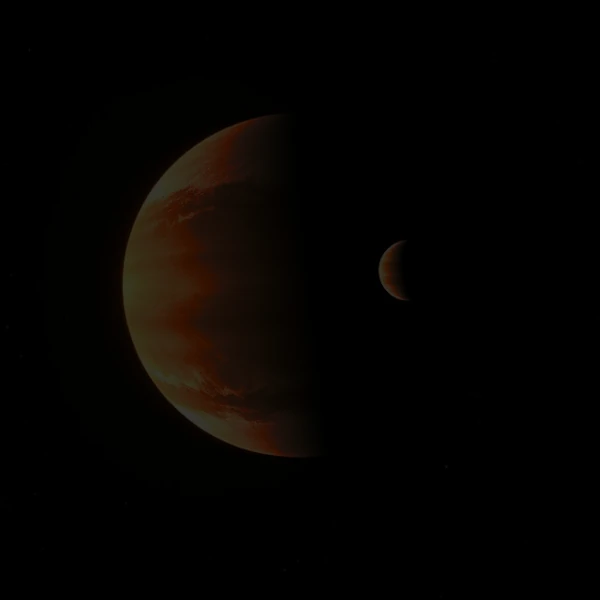
Gonggong, officially designated (225088) 2007 OR₁₀, is one of the largest objects in the Kuiper Belt, the icy region beyond Neptune's orbit. Discovered in 2007 by the team of Meg Schwamb (1983-), Michael Brown (1965-), and David Rabinowitz (1960-), this celestial body exhibits orbital characteristics that make it a fascinating subject for astronomers.
With an estimated diameter of about \(1230 \text{ km}\), Gonggong ranks among the largest known trans-Neptunian objects. Its surface has a pronounced reddish color, suggesting the presence of tholins, complex organic compounds formed by the irradiation of ices by cosmic rays and solar radiation.
Although not officially classified as a dwarf planet by the International Astronomical Union, Gonggong meets all the necessary criteria. Its study provides insights into the conditions of the early Solar System and planetary formation processes.
N.B.:
Tholins are complex organic macromolecules formed by ultraviolet irradiation of simple organic mixtures such as methane and ethane. They are responsible for the red colors observed on many trans-Neptunian objects.
Gonggong's orbit is remarkable in several ways. With a semi-major axis of about \(67 \text{ AU}\) (astronomical units), it lies well beyond Neptune. Its orbital eccentricity of \(0.5\) means its distance from the Sun varies significantly, from about \(33 \text{ AU}\) (Perihelion) to about \(101 \text{ AU}\) (Aphelion).
This highly elliptical orbit takes it from distances comparable to Pluto's to much more remote regions, completing a revolution around the Sun in about \(547 \text{ Earth years}\).
In 2016, observations from the Hubble Space Telescope revealed that Gonggong has a moon, named Xiangliu. This discovery allowed astronomers to estimate the mass of the system more accurately using Kepler's third law: \[ M_1 + M_2 = \frac{4\pi^2 a^3}{G T^2} \]
Where \(M_1\) (\(1.75 \times 10^{21} \text{ kg}\)) and \(M_2\) (\(2.3 \times 10^{19} \text{ kg}\)) are the masses of Gonggong and Xiangliu, \(a\) (\(\approx 24,000 \text{ km}\)) is the semi-major axis of the moon's orbit, \(T\) (\(\approx 25 \text{ days}\)) is its orbital period, and \(G\) is the gravitational constant.
| Parameter | Gonggong | Xiangliu | Unit |
|---|---|---|---|
| Mass | \(1.75 \times 10^{21}\) | \(2.3 \times 10^{19}\) | kg |
| Estimated Diameter | 1230 | ~100 | km |
| Rotation Period | 44.8 | Synchronized | hours |
| Semi-major Axis | 67.3 | 24.0 | AU / ×10³ km |
| Orbital Period | 547 | 25.2 | years / days |
| Albedo | 0.14 | Unknown | - |
| Average Temperature | < 50 | < 50 | K |
Source: Minor Planet Center - (225088) 2007 OR₁₀ and NASA - Hubble Telescope Discoveries.
Gonggong's particularly eccentric orbit, with an eccentricity of \(0.50\), is one of its most remarkable features. This value means that its distance from the Sun varies threefold between perihelion and aphelion, creating extreme environmental conditions that challenge standard planetary formation models.
This pronounced eccentricity is mainly explained by past orbital resonances with Neptune. According to the work of Rodney Gomes (1958-) and Hal Levison (1954-), Gonggong would have undergone repeated gravitational interactions during the planetary migration of the early Solar System. These perturbations would have gradually excited its orbit, increasing its eccentricity over billions of years.
Numerical simulations suggest that Gonggong may have been temporarily captured in a 3:10 resonance with Neptune. This resonance, although transient, would have been sufficient to permanently alter the orbital parameters of the trans-Neptunian object.
N.B.:
Orbital eccentricity is a parameter that measures the deviation of an orbit from a perfect circle. An eccentricity of 0 corresponds to a circular orbit, while a value close to 1 indicates a highly elliptical orbit. Gonggong's eccentricity (0.50) is one of the highest among large trans-Neptunian objects.